The first Japanese Kei Sports car that I drove came to me as a courtesy car.
You might think that it’s crazy, giving a garage customer a turbo-charged, intercooled mini rocket as a courtesy car; and, after I drove that 1993 Suzuki Alto Works i.e., I thought it was a crazy thing, too.
I guess that the garage didn’t have any other courtesy cars available that day. But the mechanic was not completely irresponsible, I mean, before I drove out in that mini Millennium Falcon, he said to me:
“Ah….This car is kind of fast, O.K.? So, like, just take it easy, eh? The power really comes on, like…so…just be careful.”
It was the first time (and only time since) that I have ever had a garage courtesy car that came with a…..a warning.
I’d gone into that repair shop in the secondhand, and not ultra fast, 1990 Suzuki Jimny (JA11) that I had picked up not long after arriving here in Japan (and there’s lots of those light 4WD cars still on the roads here and available for export by the way) and I drove out in that pocket rocket Alto Works.
“It’s kind of fast, O.K.? So take it easy.”
That Kei sports car was fast; and did I take it easy? No way! I had a ball with that car every day that my Jimny was in the shop. I did not want to give that courtesy car back to the garage in the end. From that moment, I had caught Japanese Kei Sports Fever, and it has never been cured since.
I really got into Kei Sports cars after that, studied about them, shopped around in Japan for one, drooled over the nice ones I saw on the streets here, took every chance to test drive the Kei Sports cars owed by friends and friends of friends, and then finally bought one; and that is the car, the Mitsubishi Minica Dangan (Bullet) ZZ that I wrote about in my first post about Japanese Kei Sports Cars here on our Japan Car Direct blog.
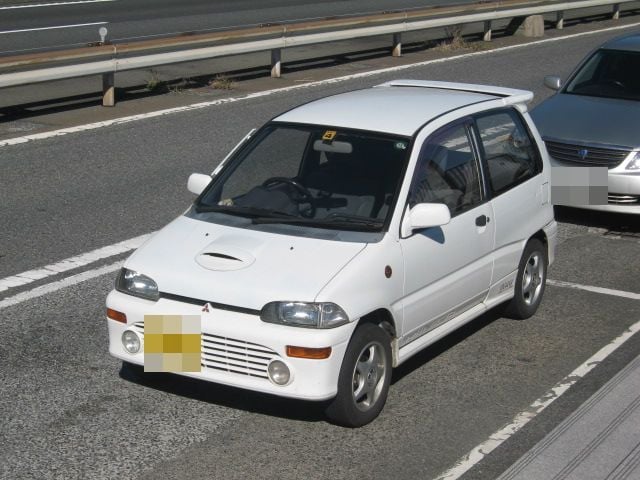
Now what about some of the other Kei Sports Cars that you can import from Japan?
O.K., I’m going to give you a bit of a gallery now, so bear with me. But, before anything, we have to set a bit of a dividing line here if we are going to really get our teeth into the whole Kei car thing; and that dividing line is this: Pre November 1998 and Post November 1998. Why these dates? Well, that’s when the Japanese government regulations about Kei vehicles changed. They all became 10cm longer and 8cm wider. “Big deal, eh? They’re still small,” you say. Sure, it’s no big thing (unless you have a narrow Japanese size parking space like I do). But it’s not so much the size, “It’s the weight, Dear.”
All the post November 1998 Kei sports cars are a bit heavier than the pre November 1998 ones (except the new Alto Works, yeah!). Now, one of the great things about these Kei sports cars, and what makes them worth importing all the way from Japan, is partly this ultra light weight thing. Truly, it’s one of the factors that sports car purists value most highly. It’s one of the reasons that some guys will pay big money for a Lotus Elise or a Caterham-7. Like Colin Chapman said: If you add power, your sports car will go faster in a straight line; if you reduce weight, it will go faster in every way, and stop faster, too. And, looking at what’s available outside Japan in the light sports car category that could be as light and come with as rigid a chassis as a Kei sports car, it seems like….well, not much is available. And you’ll pay pot money for whatever you do find, like your Lotuses and Caterhams. But a Japanese turbo or supercharged Kei will not break your wallet, and the costs for finding, shipping, documentation, etc. (all of which we will handle for you here at Japan Car Direct), are quite reasonable in the end. That’s why we are exporting more and more Kei vehicles from Japan these days, and the trend looks to continue.
O.K. let’s look at the best that’s available now in the second hand market in Japan at the auctions and dealers.
The Best Pre November 1998 Japanese Kei Sports Cars
First up, and the pre November 1998 Japanese Kei sports car that I recommend more than any of the others, is the turbo-charged Suzuki Alto Works.
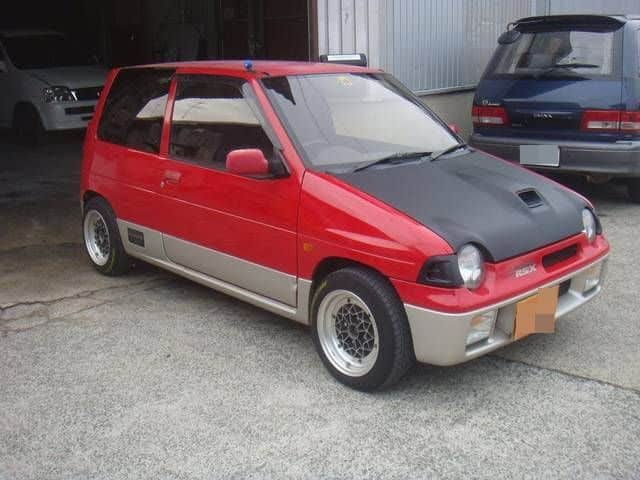
This is the quintessential Japanese mini sports car, and if you are looking to import one yourself from Japan to, say, the USA, to Canada, the UK, Taiwan, or the countries of the EU, then the Alto Works should be high on your list. It’s basically the lightest of the Kei Sports hatchbacks, and was in production from February of 1987 to December of 2000. The Alto Works then went out of production for many years until Suzuki brought the vehicle, and the concept, back into production in December, 2015.
Next up on my list of the best Kei sports cars for export from Japan comes the super-charged Subaru Vivio RX-R.
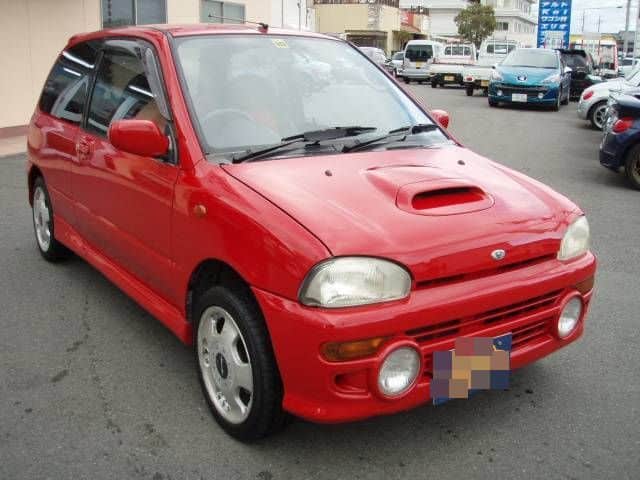
These cars were in production from March 1992, until November 1998.
We recently shipped a nice 1994 Vivio RX-R to the USA.
Again, they are very light machines and are as compact as the Alto Works. We are scoring good examples of the RX-R and Alto Works from both the Japanese used car auctions and from the secondhand car dealers that we work with here in Japan.
The next pre November 1998 Kei sports that I would go for now is the Daihatsu Mira TR-XX Avanzato. This is a solid car; again, very light, and, like the Alto Works, it has a turbo-charged, intercooled engine.
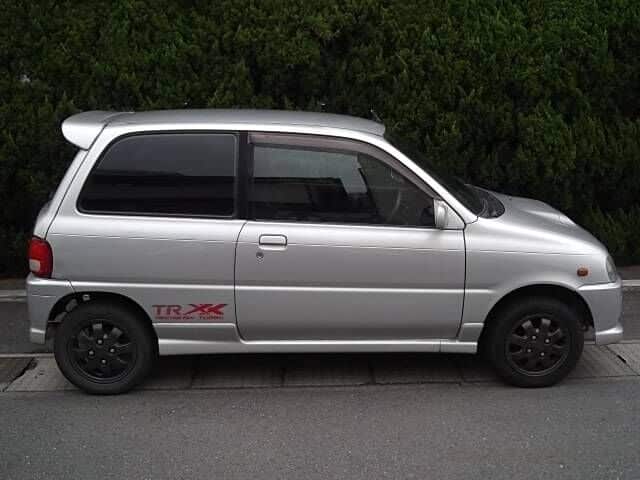
Of the hatchback bodied pre November 1998 Japanese Kei Sports Cars, these three are my first picks.
As far as the other hatchback Kei sports cars go, there are a few other like the Daihatsu Leeza:
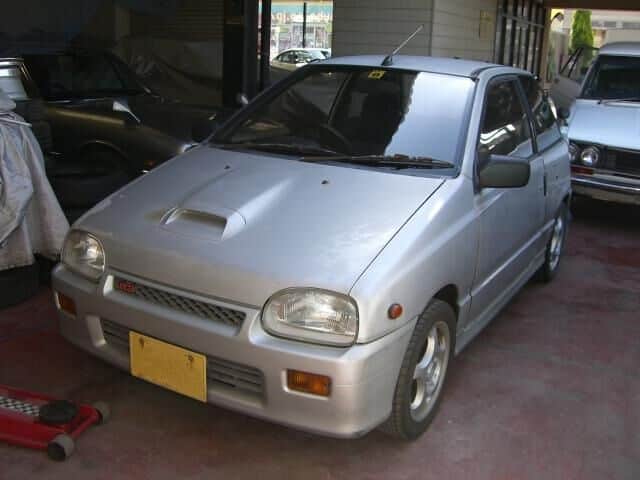
but these are getting rare now. In addition, I have not driven one so I can’t say anything about them from my own experience.
And then there is the Mitsubishi Minica Dangan that I had and that I praise to the skies, but, the 5-valve engine in that guy was such a rare piece of kit that you can’t find full overhaul parts sets now if you need to do a rebuild. So because of that, and only because of that, I don’t recommend buying and exporting one from Japan.
(We have more info about turbo Kei cars; check out that link for pics and more.)
O.K., let’s talk more seriously now about the Alto Works, my top pick for exporting direct from Japan.
The Suzuki Alto Works
As I said at the beginning of this post, the Alto Works was the first Japanese Kei Sports car that I drove, and it came to me as a courtesy car.
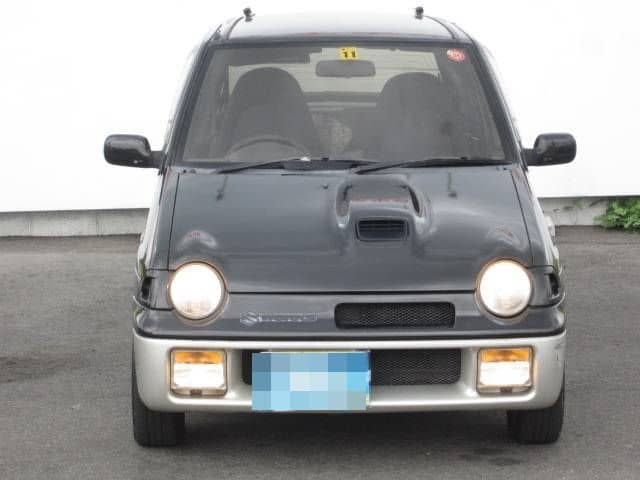
It was a black 1993 Alto Works i.e., and for days after first driving it I couldn’t stop telling everyone at work how great it was. (This may have been a problem for me as I was working at competitor of Suzuki at the time.) The car thrilled me with its responsive, sharp handling, great feedback from the road, sure-footed balance in corners and sprightly acceleration. And I really liked the face.
The car would have fit right in zooming down a sunny autostrada in southern Italy.
I noted, too, that the car had good interior room and that I, at nearly six feet, did not feel at all cramped. The rear passenger area was also quite roomy.
The cockpit dash board and wheel were just….cool.

For pure motoring fun, I recommend these cars quite strongly. Simplicity and light weight, joined to a highly-tuned, high-revving engine is the right combination in my book. Colin Chapman would understand these cars.
They are also popular at club racing events and there are a good number of tuning options. I know guys who are getting 110 to 120ps from these cars.
The Subaru Vivio RX-R
Right up there with the Suzuki Alto Works, I recommend the Subaru Vivio RX-R.
Like the Alto Works, it is a light, zippy little rocket. The big difference between the two cars is that the RX-R uses a supercharger (with intercooler) rather than the turbo found in the Suzuki.
I’ve had a chance to horse around in both the All-Wheel-Drive (AWD) and the Front-Wheel-Drive (FF) versions of these cars and I was very impressed with both. (This is what comes of having generous car-maniac friends.)
What a blast the Vivio RX-R is to drive!
It grunts very well from zero, as you would expect with that intercooled, supercharged 660cc DOHC 16-valve, in-line four cylinder. (The EN07 engine.)

It handles the sharp, tight corners of the mountain roads and back roads here in Japan with the snappy precision you’d expect from a low-slung, light weight sports car.
And it gives all this driving fun cheaply: 18.2km/l for the manual AWD (but only 16.8 km/l for the AWD RX-RA with its closer ratios) and inexpensive Kei car parts and simple Kei car mechanicals keep maintenance costs reasonable.
Cheap running costs and good gas mileage are equally true of the Alto Works, with an added advantage to the Alto Works that it burns regular gas, while the RX-R wants premium. (Aaaah! If it seems to you that I just can’t choose between these two cars, well….you’re right.)
I have also tested the 2WD Vivio RX-R and, while I’ve no complaints about the 2WD version, I did note that that little supercharged engine will easily spin the front wheels in a clutch dump take off due to all the good low-end torque that that little monster engine is packing.
I’d say the RX-R is nimble, quick, bright and charming; easily the equal of the Alto Works, a very engaging little sports car.
And I’d say that the Alto works is nimble, quick, bright and charming; easily the equal of the Vivio RX-R, another very engaging little sports car.
Nope. I just can’t choose. I’ll be happy having either one, and you’ll be happy exporting either one from Japan if that’s what’s on your mind; if you’re saying to yourself: “I want to import a Kei Sports Car direct form Japan.”
Daihatsu Mira TR-XX Avanzato
When it comes to the Avanzato, I can’t give you as solid a review as I can with the Alto Works and with the Vivio RX-R. When I test drove the TR-XX, I was not in a location that I could really cut loose. I drove the Alto Works and the Vivio RX-R in many different places, including mountain roads and highways and in town, but my time in the Daihatsu was only in town.
But I can say that the TR-XX felt like a well built car: solid, good balance, nice and quick. I felt comfortable in that Kei sports car, too.
If you are looking to export a hatchback type Kei sports car from Japan, you can’t go wrong with any of these cars. It’s really down to which car you prefer on the basis of looks and styling, and, of course, the turbocharger vs. supercharger question.
On the Question of Superchargers vs. Turbochargers for Kei Sports Cars:
From the mechanical theory point of view, a turbocharger involves a more complex technology, but in practice they tend to be more reliable. This is partly because a supercharger puts more stress on the bottom end (crankshaft main bearings, for example); the supercharger gives boost from very low rpms, which is nice for a fast take off from start (something you clearly feel in the RX-R), but the oil pressure in the engine at low rpm is less and thus is providing less protection to the moving parts under stress.
The turbo usually needs the engine to spin up a bit to give boost, which also lets the oil pressure build up, thus protecting the engine’s moving parts better.
That’s the main theory, anyway.
Turning to real cars: the Subaru superchargers are quite reliable in practice and so are the Suzuki turbos. From my experience, my supercharged Subaru Sambar never gave trouble and my understanding from guys that have Vivio RX-Rs is that they last well. From my experience with Suzuki turbos, the turbo on my Jimny went early at about 75,000kms just after I bought the car second hand because the previous driver had not replaced the broken thermostat and so the car was running in a condition of not being fully warmed up. This killed the turbo. (Key point for turbos is warm up and cool down. If you do that, you get long life from them.)
A good side point here for sports Kei buyers looking to export a used Kei car from Japan is to see if the car has had a turbo timer installed by the previous owner. This is a good sign.
So generally, from a reliability point of view, both systems are good.
From a tuning point of view, turbos are easier to tune, and there are lots of tuning parts for the Alto Works. (But having said that, there are tuning parts for Subaru supercharged Kei engines, too.)
In my next post about Japanese Kei Sports cars. I’ll tell you about the two best non-hatchback bodied cars that I have driven, the Suzuki Cappuccino and the Honda Beat, and I’ll also tell you about the post November 1998 Japanese Kei sports cars that are coming available for export direct from Japan.



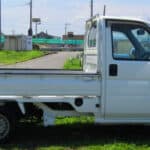




Leave your questions and comments, we look forward to replying!